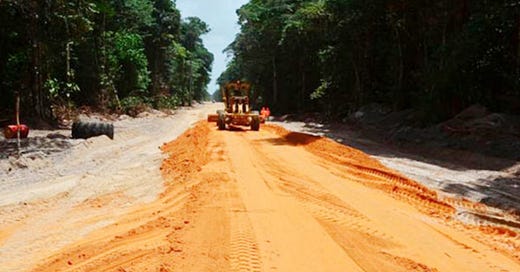
The controversy surrounding the proposed Amaila Falls hydropower dam in Guyana continues. Ex-President Bharrat Jagdeo publicly committed to building the dam before he left office. Like many of Jagdeo’s other promises, this came to nothing.
The lead developer of the 165 MW dam is Sithe Global, which is part of the Blackstone Group, a giant New York-based private equity, investment banking, alternative asset management and financial services corporation. In 2009, Sithe Global signed a take-or-pay power purchase agreement, which guarantees a 19% rate of return to Sithe Global. Sithe Global will provide more than US$120 million in equity funding during the construction period. In September 2012, China Railway First Group signed an engineering contract. Most of the money for the US$840 project will come from the China Development Bank. The IDB has been asked to fund US$175 million.
The access road to the construction site has still not been completed. In January 2012, the government sacked Synergy Holdings, the company that won the contract to build the road, after a series of delays and cost overruns. The contract involves constructing 85 kilometres of new road and upgrading 122 kilometres of existing roads. Last week, the Kaieteur Times described the project as “on rocky ground at the moment”, with the access road far from complete and a deadline to meet at the end of this year.
If the road is not completed at the end of the year, Sithe Global and China Railway First Group could invoke penalty clauses resulting in Guyana paying a percentage of the total project sum. The cost of the road construction is already 33% over budget. The government awarded China Railway First Group the contract to finish the access road.
In April 2013, the opposition parties in Guyana blocked funds for a government equity-stake in the Amaila Falls project. One of the opposition parties, the Alliance for Change (AFC) recently said that it would not make a decision on releasing the government funds until the Inter-American Development Bank (IDB) completes its financial due diligence of the project.
The government equity-stake in the project could total US$80 million. The money would come from Norway’s Guyana REDD-Plus Investment Fund (GRIF) – the Amaila Falls project is one of the few projects under Guyana’s Low Carbon Development Strategy.
At full capacity the dam could generate more than Guyana’s current power needs, and after 20 years the ownership of the dam would transfer to the government with the construction costs paid off. But there remain serious questions about the project.
Normally, the IDB sets up an advisory expert panel to help selection of the environment and social impact assessment team and other due diligence activities. In the case of the Amaila Falls project, the IDB’s expert panel only started its work after the environment and social impact assessment team had visited the project area. The IDB expert panel’s report from 2011 has not been made public.
Recently, the Economist listed a series of problems with the project, under the headline “Shrouded in secrecy”:
Guyana Power and Light, the state-owned electricity company will end up paying around US$100 million per year to the Amaila Falls consortium.
Electricity bills in Guyana are unlikely to fall.
The Amaila Falls dam may not generate electricity all year round. Between October and April (the dry season in that area of the country) the dam will run at less than capacity. GPL will have to pay for backup power. The El Niño weather pattern can result in a year-long drought.
The estimated cost of the dam has increased steadily. The IMF has urged “careful consideration of the [financial] risks”.
The financial feasibility study is not yet completed. When it is, it will remain confidential.
GPL’s power-purchase agreement is also confidential.
The Economist concludes its article with the observation that,
If Amaila is as beneficial as its backers claim, an open debate might generate broader support for the project, and cut its $56m bill for political risk insurance.
Isn’t REDD supposed to increase transparency? Shouldn’t the involvement of Norwegian money, via the GRIF, mean that Norway is demanding transparency? Apparently not.





Comments following the original post on REDD-Monitor.org are archived here: https://archive.ph/CHv6J#selection-807.4-807.14